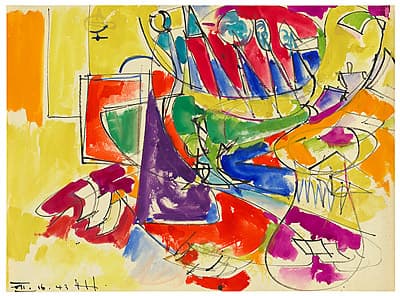
Hans
HOFMANN
Germany
1880
–
United States of America
1966
Untitled
1943
charcoal, watercolour, brush and ink
signed and dated l.l. with brush and ink "VII 16.43 HH".
sheet
45.0 (h)
x 60.6 (w)
cm
Purchased 1980
National Gallery of Australia, Canberra
NGA 1980.3406
© Renate, Hans & Maria Hofmann Trust/ARS. Licensed by Viscopy
- estate of Hans Hofmann M 6642;
- with André Emmerich Gallery, New York;
- from whom bought by the Australian National Gallery, November 1980
- Hans Hofmann
- Corcoran Gallery of Art 01 Jun 1973 – 08 Jul 1973
- 52 works on paper
- Corcoran Gallery of Art 02 Jun 1973 – 15 Jul 1973
- University of Michigan Museum of Art 15 Oct 1973 – 15 Nov 1973
- University Art Museum, University of California 15 Jan 1974 – 15 Feb 1974
- Arkansas Art Centre 15 Apr 1974 – 15 May 1974
- Tyler Museum of Art 15 Jul 1974 – 15 Aug 1974
- Palm Springs Desert Museum 15 Apr 1975 – 15 May 1975
- Wichita State University 01 Sep 1975 – 30 Sep 1975
- Mint Museum of Art 01 Dec 1975 – 31 Dec 1975
- Hans Hofmann: 52 Works on Paper
- International Exhibitions Foundation 1973-09- – 1975-12-
- Hans Hofmann: The American Years, 37 Works on Paper
- 01 Apr 1976 – 01 Jun 1978
- Abstract Expressionism: the National Gallery of Australia celebrates the centenaries of Jackson Pollock and Morris Louis
- 14 Jul 2012 – 24 Feb 2013
The brilliant colouring and freely expressive forms of Untitled 1943 disguise the sophistication and development of Hofmann’s style as he was transformed from a European into an American artist. Even more than other emigrés, Hofman brought with him a vast knowledge of avante-garde styles and practices, evident in his history and friendships in Germany and France in the first decades of the twentieth century. Hofmann left Paris just before the outbreak of war in 1914, and stayed in Munich for the duration. There he was a friend of Kandinsky’s partner Gabriele Műnter. After Kandinsky was expelled as an enemy alien and returned to Moscow, Műnter asked Hofmann to look after his paintings until they could be retrieved after the war. Such exposure to the most important abstract artist of the time, especially the lyrical Compositions and Improvisations, has a legacy in Hofmann’s work that can be seen here. Műnter gave Hofmann a watercolour by Kandinsky, which he treasured for the rest of his life.
Sheer energy is released by a large field of yellow watercolour overlaid by dynamic lines of brush and ink. Curved yellow and green shapes swoop from the upper right, and break into an opposing broken path which reaches down into the lower right. The intensity of colour is partially offset by the semi-transparent medium of watercolour, and Hofmann’s artful placement of almost pure blocks of paint side-by-side, rather than overlaying them. Rectangles of orange and red are counterpointed by violet and blue triangles and circles, becoming a whole which forms a powerful, joyously agitated landscape.
Christine Dixon
The National Gallery of Australia holds one painting and five drawings by Hofmann: two female nudes of 1935, a self-portrait c. 1932–35, all brush and ink; and two untitled drawings of 1943, brush and ink, one with watercolour and charcoal.
